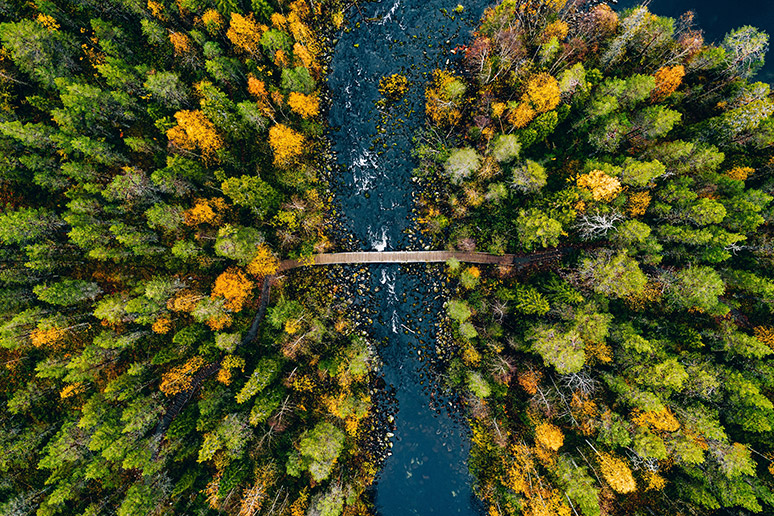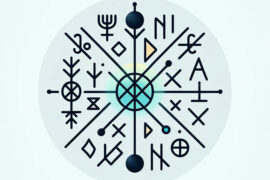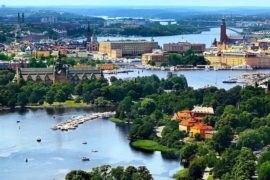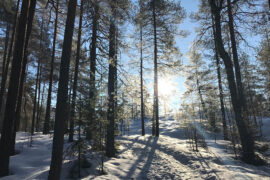Finnish mythology is rich with legends about gods, heroes and other weird and wonderful creatures.
And although it hasn’t broken into the public consciousness in the same way as Norse mythology, Finnish mythology is fascinating and beautiful in its own way!
Let’s explore some of the basic ideas in Finnish mythology.

Origins of Finnish mythology and The Kalevala
Finns have been passing down the stories of their guardians for centuries. These stories were told long before Finland had converted to Christianity.
After many years of these stories being recounted orally, from one generation to the next, they were eventually written and published.
The most famous work in Finnish mythology is titled ‘The Kalevala’.
The Kalevala (kah-leh-VAH-luh), written by Elias Lönnrot, contains the myths and legends of Finland as well as the creation of the Earth.
The Kalevala is commonly regarded as Finland’s national epic and is one of the most significant pieces of Finnish literature. It is written through a series of poems, ballads, and songs.
However, it’s important to note that The Kalevala was not the first written text about Finnish mythology.
In the 16th century, a man named Mikael Agricola wrote down important details regarding the myths of Finland in order to preserve the information. Today, Agricola is known as the ‘father of literary Finnish’.
With that being said, The Kalevala still remains one of the most well-known works in Finland and has even inspired modern-day writers.
The main characters of The Kalevala
There are quite a few figures in The Kalevala, and it’s important to know a bit about them in order to give the stories more context. Let’s introduce you to a few of them!

Väinämöinen
Often regarded as the main character in The Kalevala, Väinämöinen is a powerful and heroic demigod. More accurately, he is a hybrid of a bard, shaman, and wizard.
If you’re familiar with The Lord of the Rings series, he is frequently compared to the character ‘Gandalf’.
Väinämöinen is a very wise man and has a talent for music. In fact, he sings… magically. Yes, you read that right!
If you come across pictures or paintings of Väinämöinen, you may notice that he is often depicted holding an instrument. This instrument is the kantele, a traditional Finnish harp.
His kantele-playing skills were so breathtaking, that not only would people listen to him play, but animals and other godly beings did as well.
Ilmarinen
Another key figure in The Kalevala is Ilmarinen. Ilmarinen is the god of air and is a master metalworker and blacksmith.
Ilmarinen crafted numerous magical artifacts featured in The Kalevala. The most well-known of these artifacts is Sampo – a very powerful object that essentially creates riches out of thin air.
The Sampo has three sides: the first side would make salt, the second would make grain, and the third would make money.
Sampo makes many appearances throughout The Kalevala, as many of the deities repeatedly try to steal it. Who wouldn’t want limitless riches?
It is also said that Ilmarinen crafted the dome of the sky, which was another one of his greatest creations.
Joukahainen
To put it simply, Joukahainen is the rival of the main character, Väinämöinen. He is a young man with a lot of confidence and believes he is superior to Väinamöinen.
Don’t get the wrong idea – Joukahainen is not a villain. In Finnish mythology, there is no ‘good’ and ‘evil’. It’s more hero vs chaos.
One day, Joukahainen challenged Väinämöinen to a singing battle, which Väinämöinen accepts. Joukahainen ultimately loses to his opponent and is then cast away to a swamp.
Lemminkäinen
Lemminkäinen is known for being a young, attractive lad who is also a great fighter. He is also very close to his mother, who is named Lempi.
One of the myths involving Lemminkäinen is of him drowning in the river of Tuonela. Tuonela is the river that separated the living from the dead, and is often referred to as ‘the underworld’.
However, Lempi would eventually bring her son back to life.
Important gods and goddesses in Finnish Mythology

Ukko: God of weather and thunder. Often compared to Thor in Norse mythology.
Tapio and Mielikki: God and goddess of the forest.
Louhi: The goddess of witchcraft. She lives in the North of Finland.
Ahti and Vellamo: God and goddess of water.
Tuoni: God of the Tuonela (the underworld).
Päivätär and Kuutar: Goddesses of the sun and the moon. They are also sisters.
Creatures in Finnish Mythology
There are also many kinds of creatures featured in Finnish mythology and The Kalevala. Let’s run through them.
Otso: A bear who is the king of the forest. Treated as a divine spirit – bears are very sacred animals in Finland!
Menninkäinen: Gnomes that are nocturnal and live underground.
Näkki: Alluring but nasty water spirit. It’s said that she lives under bridges.
Haltija: An elf-like creature who likes to help people.
Will-o-wisps: Small light spirits which are usually seen hovering over bodies of water such as ponds, or swamps. They appear at night.
Iku-Turso, or Tursas: A very scary sea monster. Resembles an octopus, but can also grow wings.
Hiisi: A demon who dwells deep in the forest. You wouldn’t want to be spotted by one of these!
Keiju: Fairy-like creatures who are very small and beautiful.

What are the myths of The Kalevala?
Now that we’ve learned about the characters and spirits of the Kalevala, we’re now ready to dive into the fascinating legends of this text.
The creation of the world
Ilmitar, a virgin spirit and a goddess of air, descends to rest in calm waters for 700 years. When she awoke, a bird had landed on her lap and laid seven eggs: six made of gold, and one of iron.
The eggs fall from her lap, landing in the water. The eggs shatter beneath her, creating the Earth. The bottom of the shell forms the land, while the top of the shell forms the sky. The white of the egg forms the moon and stars, while the yolk forms the sun.
Väinmöinen eventually crawls out of Ilmitar’s womb and sets forth on his journey. For years he swims across the seas before setting foot on land.
The Sampo
Many of the stories told in The Kalevala revolve around Sampo. Almost everyone is trying to get their hands on it!
Remember the singing battle between Väinämöinen and Joukahainen mentioned earlier? After his defeat, Joukahainen shoots an arrow to Väinämöinen, causing him to fall into the sea.
After several days, Väinämöinen finally washes up on the shores of the dark and terrifying North. This land is ruled by Louhi who is basically the wicked witch of the North.
Louhi nurses the hero back to health, but demands a reward in return. There was only one thing she desired: Sampo.
Ilmarinen, as its creator, is the only one with access to Sampo. Luckily for Louhi, she has an offer for Ilmarinen that he simply couldn’t refuse: one of her daughters.
As a result, Louhi gets Sampo, Ilmarinen gets to marry one of her daughters, and Väinämöinen is free of his debt to Louhi.
Later on in The Kalevala, Väinämöinen, Ilmarinen, and Lemminkäinen all sail to the North to steal Sampo back from Louhi.
Unfortunately, once Väinämöinen acquires the object, it falls and breaks into pieces.
More myths from Finland
The three souls
In Finnish mythology, there are three different parts of the soul: the henki, luonto, and itse.
The henki is the soul that we are born with, and it’s said that it is the source of life and responsible for our breathing. After all, the word ‘henki’ translates to ‘breath’.
Next is the luonto. The luonto can be classified as the ‘main’ soul. It enters the body at a few days old and survives the body beyond death.
Last we have the luonto. The luonto is the guardian spirit, and it is the protector of the individual. It is also associated with nature and animals.
The Northern Lights
Finland is famous for being one of the best places for seeing the northern lights. As a result, there are several legends about what they are and why they exist.
The first and perhaps most common myth involves a fox. The Finnish word for aurora is ‘revontulet’ which directly translates to ‘fox fires’.
This myth states that the lights are made by a magical ‘fire fox’ running through the snow – he runs so fast that his tail creates sparks, setting fires to the skies.
The Kalevala has a rather darker theory, as auroras are referred to as ‘the flaming gates of the north’.
The people of Lappland – a region in the Northern-most part of Finland – traditionally believe that the lights are the spirits of our ancestors.
And traditionally, some Finns believed that northern lights were caused by spell-casters!
What makes Finnish mythology unique?
Finnish mythology and The Kalevala have some pretty creative stories! Magic singing battles, the valuable Sampo, and the firefox are all unique ideas rooted in Finland.
Another fascinating trait is how Finnish mythology values nature and the forest. These values are still held today, and most Finns have a deep appreciation for Finland’s rich nature.
Elements of Finnish mythology can be spotted creeping into modern life, too: the author JRR Tolkien took inspiration from The Kalevala, for example, any many of of his works such as The Hobbit and The Silmarillion take inspiration from Finland’s national epic.
See also:
Norse vs Scandinavian: what is the difference?
Norse paganism explained
Norse gods and goddesses










I am fascinated and very glad to be introduced to the oral myths and lore of my ancestors. I am over one quarter Finn, and can relate to these stories of old, as if they are written into my bones and my spirit. Thank You, for sharing these things!